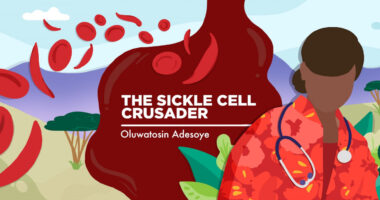Point-of-care SCD tests could enable timely care in sub-Saharan Africa
Resource-limited areas lack infrastructure for follow-up with standard screening

Point-of-care tests can be used to accurately diagnose sickle cell disease (SCD) in resource-limited settings such as sub-Saharan Africa, according to a recent study.
“Based on our experience and this study, we support the use of these [point-of-care] tests as standalone diagnostic tests for the early diagnosis of SCD in limited resource settings,” researchers wrote.
This strategy may be more useful in these settings than the newborn screening programs that have been implemented in wealthy nations like the U.S.
“The most effective way to allow for widespread diagnosis of the most common forms of SCD is by deploying these [point-of-care] tests,” researchers wrote, though they noted that efforts are needed to make these tests more affordable and accessible in resource-limited settings.
The study, “Early diagnosis of sickle cell disease at birth hospitals and vaccination centers in Angola using point-of-care tests,” was published in the journal Blood Advances.
Highest prevalence of SCD found in sub-Saharan Africa
SCD is more common in sub-Saharan Africa than in any other part of the world. More than 300,000 children with sickle cell are born in this region every year.
In the U.S. and Europe, newborn screening programs for sickle cell and other congenital disorders are increasingly common. In these programs, a blood sample is collected from babies within a few days of birth, then sent to a central laboratory for testing. If the results are abnormal, indicating the presence of sickle cell for example, the family is contacted for further follow-up testing and management.
Newborn screening programs have substantially improved outcomes for children with sickle cell by allowing early diagnosis and treatment. But in sub-Saharan Africa, most babies born with sickle cell are not diagnosed early — and most of them die before their fifth birthday due to disease complications that are otherwise preventable or treatable.
In the central African nation of Angola, a pilot newborn screening program for sickle cell, designed similarly to programs in the U.S. and Europe, was launched in 2011. Data from this program highlighted the high burden of SCD in Africa — with more than one out of every 100 babies tested ultimately found to have the disease.
While early diagnosis is critically important to reduce the burden of SCD, the traditional [newborn screening] paradigm that has been effective in the US and Europe may not be suitable for most of sub-Saharan Africa.
About half of families were lost in follow-up with standard newborn screening
However, when results from laboratory testing were positive for SCD, only about half of the families were able to be contacted for follow-up and care. This was largely attributed to a lack of broader infrastructure that may be taken for granted by people in the U.S. and Europe.
“In most African settings, there is lack of a traditional mailing system, lack of established primary care providers, and inconsistent telephone numbers, or telephones that are not able to be reached to lack of electricity to provide a charge or insufficient credits on the account,” the researchers wrote. “While early diagnosis is critically important to reduce the burden of SCD, the traditional [newborn screening] paradigm that has been effective in the US and Europe may not be suitable for most of sub-Saharan Africa.”
Based on their experience with the pilot program, the researchers proposed that point-of-care testing — where a test is performed, and the results are rapidly made available to discuss with the family during the same medical appointment — might be more useful in places like Angola where communication infrastructure is limited.
In recent years, two point-of-care tests for sickle cell have been developed: the Sickle SCAN and the HemoTypeSC. Both have shown promise for identifying sickle cell in resource-limited settings, but there’s debate about whether one or the other may be better in these settings in terms of accuracy, as well as ease of use.
A team of scientists collaborated with Angola’s Ministry of Health to learn more, with the ultimate goal of creating better systems to enable the early diagnosis of sickle cell in the country.
For the study, a total of 2,000 babies were tested with one of the point-of-care tests — half with Sickle SCAN and the other half with HemoTypeSC. All babies also had blood samples collected for laboratory testing employing the gold-standard methods used in newborn screening programs.
About two-thirds of the tests were performed at maternity centers, while 37% were done at vaccination centers.
“This study demonstrates that expansion of testing beyond the birth hospitals, to include vaccination centers, is likely to increase the numbers of infants that are tested and diagnosed,” the researchers wrote.
Point-of-care tests found to be highly accurate
Results showed that both point-of-care tests were highly accurate and lined up with findings from laboratory tests in 98.3% of the cases for Sickle SCAN and 95.3% of the cases for HemoTypeSC. When tests were inaccurate, it was usually due to errors made by clinicians in using or interpreting the test, rather than issues with the test itself. Most clinicians reported the tests were easy to use and interpret.
In the first part of the study, clinicians waited until confirmatory laboratory results were available before talking to the affected parents. Of the 10 babies diagnosed with sickle cell in this part of the study, four were able to be reached to initiate follow-up care.
By contrast, in the main part of the study where point-of-care test results were discussed at the time of testing, 22 out of 24 (92%) diagnosed babies were able to get care with a specialist SCD clinic.
Collectively, these data support the use of point-of-care tests for early diagnosis of sickle cell in resource-limited settings, the researchers stated, calling for further work to expand these programs in Angola and elsewhere.








